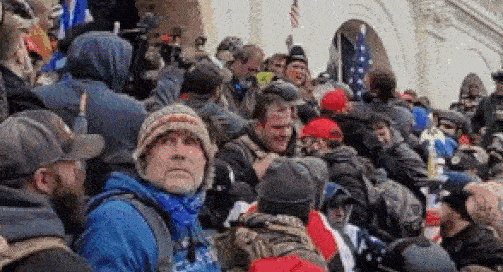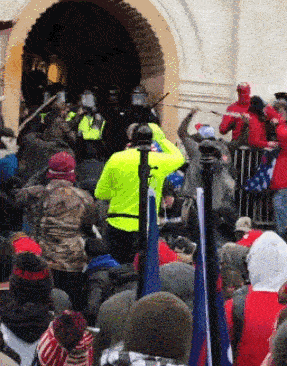Trump "liberates" domestic terrorists he incited
“What we were subjected to that day was like something from a medieval battle,” Capitol Police Sergeant Aquilino Gonell testified to Congress. “We fought hand-to-hand, inch-by-inch to prevent an invasion of the Capitol by a violent mob intent on subverting our democratic process. My fellow officers and I were committed to not letting any rioters breach the Capitol. It was a prolonged and desperate struggle. The rioters attempting to breach the Capitol were shouting, ‘Trump sent us. Pick the right side. We want Trump.’ I vividly heard officers screaming in agony, in pain, just an arm’s length from me.”
One of the brutalized officers Gonell overheard was Metropolitan Police Officer Daniel Hodges, who was crushed by Trump supporters at the U.S. Capitol’s inaugural tunnel on January 6th.
Officer Hodges told Congress that a little after 12:30 p.m.—during Trump’s speech at the Ellipse—“the protesters began their transition from peaceful assembly into terrorism.” Although originally stationed at Constitution Avenue, Hodges was called up to Capitol, where he battled the crowd for hours before meeting the worst of conditions in the tunnel. He testified:
“The two sides were at a stalemate at a metal door frame that sat in the middle of the hallway. At the front line, I inserted myself so the frame was at my back, in an effort to give myself something to brace against and provide additional strength when pushing forward. Unfortunately, soon after I secured this position, the momentum shifted, and we lost the ground that got me there. On my left was a man with a clear riot shield stolen during the assault. He slammed it against me and, with all the weight of the bodies pushing behind him, trapped me. My arms were pinned and effectively useless, trapped against either the shield on my left or the door frame on my right. With my posture granting me no functional strength or freedom of movement, I was effectively defenseless and gradually sustaining injury from the increasing pressure of the mob. Directly in front of me a man seized the opportunity of my vulnerability, grabbed the front of my gas mask and used it to beat my head against the door. He switched to pulling it off my head, the straps stretching against my skull and straining my neck. He never uttered any words I recognized but opted instead for guttural screams. I remember him foaming at the mouth. He also put his cell phone in his mouth so that he had both hands free to assault me. Eventually, he succeeded in stripping away my gas mask, and a new rush of exposure to CS and OC spray hit me. The mob of terrorists were coordinating their efforts now, shouting ‘heave-ho,’ as they synchronized pushing their weight forward, crushing me further against the metal door frame. A man in front of me grabbed my baton that I still held in my hands, and in my current state I was unable to retain my weapon. He bashed me in the head and face with it, rupturing my lip and adding additional injury to my skull.”
Sometime in the melee, MPD Officer Michael Fanone was grabbed out of the tunnel and attacked by Trump supporter Daniel Rodriguez, who tased him in the neck. The assault induced a heart attack.
Officer Fanone testified:
“They marched on the Capitol with the clear intentions of stopping the certification of the election. When they encountered the police sworn to keep us safe, they went on their attack with bear spray, knives, tasers, hockey sticks, even flagpoles fashioned into clubs with the American flag still attached. Those rioters breached the Capitol. They smashed windows, scaled walls, broke down doors, and invaded the Halls of Congress. It was a scene of violence in the citadel of our democracy not seen since 1814 when British soldiers sacked the building. [The rioters] raced through the hallways chanting, ‘Hang Mike Pence!’ ‘Where is Nancy?’ They stormed onto the Senate floor because they wanted to stop the Senate from certifying the election. The rioters tried to take over the House floor for the same reason.”
Fanone detailed the assault against him: “Because I was among the vastly outnumbered group of law enforcement officers protecting the Capitol and the people inside it, I was grabbed, beaten, tased, all while being called a traitor to my country. . . . At some point during the fighting, I was dragged from the line of officers and into the crowd. I heard someone scream, ‘I got one.’ As I was swarmed by a violent mob, they ripped off my badge. They grabbed and stripped me of my radio. They seized ammunition that was secured to my body. They began to beat me with their fists and with what felt like hard metal objects. At one point, I came face-to-face with an attacker, who repeatedly lunged for me and attempted to remove my firearm. I heard chanting from some in the crowd: ‘Get his gun and kill him with his own gun.’ I was aware enough to recognize I was at risk of being stripped of and killed with my own firearm. I was electrocuted again and again and again with a taser. I’m sure I was screaming, but I don’t think I could even hear my own voice. . . . During those moments, I remember thinking there was a very good chance I would be torn apart or shot to death with my own weapon. I thought of my four daughters who might lose their dad.”
In the end, 138 officers reported injuries—including a lost eye, lost fingers, broken ribs, concussions, and a heart attack—and five died as an apparent result of physical and emotional trauma. Officer Brian Sicknick died of strokes triggered by the assault, and four officers died by suicide. Additionally, four Trump supporters died during the Capitol raid—Rosanne Boyland, Kevin Greeson, Benjamin Philips, and Ashli Babbitt. Trump supporter Christopher Georgia died by suicide. (Incredibly, Trump has downplayed the loss of life and sided with the Capitol assault as a “day of love.”)
Two weeks after Trump supporters violently attempted to overturn the election, Joe Biden walked through the inaugural tunnel and took the oath of office at the site of one of the worst acts of domestic terrorism in the history of the United States.
That day, President Trump broke tradition and refused to attend the inauguration. Instead, he flew home with boxes of classified materials later declared missing from the National Archives.
Four years after the Capitol assault, Trump returned to the scene of the crime and took the oath of office in the Capitol Rotunda. Neglecting to place his hand on the Bible, Trump nonetheless pledged to “faithfully execute the Office of President of the United States” and to “preserve, protect and defend the Constitution of the United States.”
Defending the Constitution requires that the president act in accordance with its explicit purpose, which is to “establish Justice, insure domestic Tranquility, provide for the common defence, promote the general Welfare, and secure the Blessings of Liberty to ourselves and our Posterity,” to “guarantee to every State in this Union a Republican Form of Government,” and to protect states “against domestic violence.”
To side with domestic terrorists violates the oath.
But that is exactly what Trump did the day of his return to office. Declaring in his inaugural speech that January 20, 2025, is “Liberation Day,” Trump did not directly explain his meaning. It only became clear later in the day that his idea of “liberation” is to pardon criminals willing to do anything for him, those who risked life and liberty to invade the Capitol, assault police, and prevent the peaceful transfer of office.
Trump’s approval of January 6 rioters goes beyond pardoning common or harmless criminals, and extends to domestic enemies—such as Proud Boys and Oath Keepers convicted of “seditious conspiracy.” The U.S. Code defines seditious conspiracy as a plot between persons “to overthrow, put down, or to destroy by force the Government of the United States,” or “to prevent, hinder, or delay the execution of any law of the United States,” or to seize governmental property (such as the U.S. Capitol Building). Sedition is a threat against the peace and order (“domestic tranquility”) of the United States. Trump went out of his way to commute sentences for the most notorious seditionists.
The U.S. Code defines “domestic terrorism” as “activities dangerous to human life” that appear intended “to influence the policy of a government by intimidation or coercion” or “to affect the conduct of a government by mass destruction,” such as occurred at the Capitol on January 6, 2021.
Trump’s solemn oath barely hung in the air before it betrayed the people. To release domestic enemies of the United States robs justice and encourages sedition. Furthermore, the U.S. president used the word “patriots” to describe persons who harmed law enforcement officers and sought to disrupt a peaceful and necessary function of government.
What kind of message does that send?







